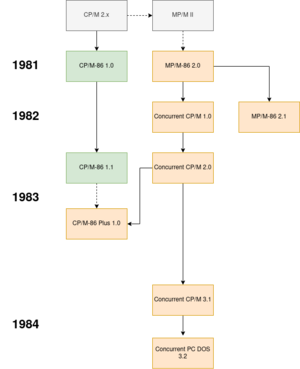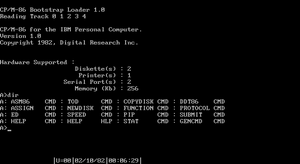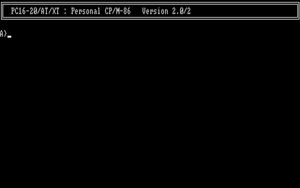CP/M-86 Timeline

This is a project aiming to document the timeline of various versions of the CP/M-86 operating system, focusing primarily on those released for the IBM PC.
The various names of the operating system include CP/M-86, CP/M-86 Plus, MP/M-86, Concurrent CP/M-86, Personal CP/M-86, Concurrent DOS, DOS Plus, Concurrent PC DOS (not to be confused with IBM PC DOS), Concurrent DOS 286, Concurrent DOS 386, Concurrent DOS XT, Multiuser DOS (not to be confused with Microsoft's Multitasking DOS 4), and FlexOS.
The most important fact about each version is BDOS, which is the part of the CP/M kernel that interfaces with userspace applications. The BDOS version can be easily deduced via the function 12 system call, however, it doesn't say everything about the API, since Digital Research didn't always update the BDOS number when adding new calls. Original CP/M-86 uses BDOS 2.2, most MP/M-based versions use 3.x and 4.x, Concurrent DOS 6.x uses 6.x.
What to document
For each version, the following information is collected into a table:
- Date of release, or at least the year if unknown
- Release name and version
- Following patches to the release, if any (e.g. CP/M-86 1.1 for IBM PC XT)
- BDOS version, as reported by function 12 (MRTVNO)
- The version's predecessor, if applicable and interesting
- Specific API differences, if applicable
- Present features, especially DOS filesystem support, DOS application support, and multitasking
- Supported media types (e.g. fixed disk, 160k floppies, ...)
- Links to preserved copies: source, binaries, and floppy images, both official and unofficial
- Links to manuals (User's Guide, System Guide, Programmer's Guide), DRI manuals are good sources of information
The CP/M-86 history documentation project channel on Discord is the chat associated with the project, you can join it if you are interested in helping out.
Lingering questions
- How were resources used to generate the CCPM.SYS kernel distributed? The typical CCP/M distribution includes everything to develop programs in assembler (ASM86, GENCMD, DDT86), but not GENCCPM and the .CON files. Generating a kernel is needed to include Resident System Processes, was that reserved to hardware manufacturers only?
- Is it possible to reconstruct the original .CON, .MPM and .H86 files (eventually .A86 disassembled source) from built CPM.SYS, MPM.SYS, PCPM.SYS, and DOSPLUS.SYS kernels? How difficult is it? (The CP/M-86 1.1 BIOS linked below was reconstructed this way, disassembled and annotated.)
- Does the Concurrent DOS 6.0 P_CLI (Supervisor Command Line Interpreter call) interpreter accept DOS or CP/M-86 commands?
Timeline table
| Version name | BDOS version | Release date | Based on | Features | Supported media types | Links |
|---|---|---|---|---|---|---|
| CP/M-86 for IBM PC 1.0 | 2.2 | 1982-04-05[1] | Presumably CP/M 2.2 | - | IBM PC CP/M single-side (160k) and double-side (320k) floppy disks | 160k floppies (WinWorld), manuals (WinWorld) |
| Concurrent CP/M-86 1.0 | 3.0[2] | August 1982User's Guide | MP/M-86 2.0[note 1] | Multitasking, virtual screens | As above | 160k floppies (WinWorld), manuals (WinWorld) |
| CP/M-86 for IBM PC 1.1 | 2.2 | March 1983Kernel timestamp | CP/M-86 for IBM PC 1.0 | - | As above | 160k floppy 1 + GSX (WinWorld), floppy 2 (files only)[note 2], release notes |
| Concurrent CP/M-86 2.0 for IBM PC | 3.1[3] | 1983-04-30XIOS source date | Presumably Concurrent CP/M-86 1.0 | Multitasking, virtual screens | ? | Source code, manuals (WinWorld) |
| Concurrent CP/M-86 2.0 for Texas Instruments Professional Computer | Likely 3.1 | 1983-04-30XIOS build date | Presumably Concurrent CP/M-86 2.0 | As above | IBM PC CP/M double-side (320k) floppy disks, "Winchester" fixed disk | 320k floppies (WinWorld) |
| CP/M-86 for IBM PC and IBM PC XT 1.1 | 2.2 | August 1983BDOS source date | CP/M-86 for IBM PC 1.1 | - | IBM PC CP/M single-side (160k) and double-side (320k) floppy disks, IBM XT (and later) fixed disk | 320k floppy (WinWorld), BDOS and CCP source code |
| CP/M-86 Plus 1.0 for Apricot PC | 3.1 | November 1983Installation guide | Likely Concurrent CP/M-86 2.0, partly CP/M-86 1.1[note 3] | Simple multitasking | ? | Installation guide |
| Concurrent CP/M-86 3.1 for IBM PC | 3.1 | 1984-01-01 | Concurrent CP/M-86 2.0 for IBM PC | Multitasking, virtual screens, windowing, DOS application support add-on | Same as above | 320k floppy 1 (WinWorld), source code, manual (WinWorld) |
| Concurrent PC DOS 3.2 | 3.2 | 1984-08-30 | Concurrent CP/M-86 3.1 for IBM PC | Multitasking, virtual screens, windowing, DOS-like shell, DOS application support | All above, PC DOS 2.0 single-side (180k) and double-side (360k) floppy disks | 320k/360k floppies (WinWorld) |
| Concurrent PC DOS 3.2 Maintenance Release | 3.2 | 1984-10-19 | Concurrent PC DOS 3.2 | Same as above | Same as above | 320k/360k floppies (WinWorld) |
Detailed information
Here you can find detailed information about the most important versions of CP/M-86, which doesn't fit into the table above.
CP/M-86 for IBM PC 1.0

Officially named CP/M-86 for the IBM Personal Computer Version 1.0, this is the first version of CP/M-86 for the IBM PC. It was delayed around eight months after the IBM PC release in August 1981, giving it a late start against IBM PC DOS 1.0, itself a clone of CP/M. Minimum RAM required for the system to boot is 32kB, although at least 48kB is needed to fit a non-trivial application like PIP and STAT.
Unlike DOS, which ships with IBM BASIC as the built-in programming tool, CP/M-86 included ASM86, an 8086 version of the CP/M-80 assembler ASM. The assembler produces .H86 files with machine code, which can be transformed into relocatable executables wit h the GENCMD utility; this is an improvement upon both CP/M-80 and DOS, both of which use memory images (raw binaries) for programs. CP/M-86 manual also metion a LMCMD program for creating .CMD file from Intel 8086 relocatable object files (which are likely produced by Intel tools like the PL/M compilercitation needed), but the IBM PC distribution doesn't ship it.
CPM-86 1.0 for IBM PC is an adaptation of the earlier CP/M-86 codebase developed from 1979 to 1981; the dates of 15 December 1981 and 28 December 1981 can be found on the install media. Unlike later versions, the kernel is not contained in a file named CPM.SYS, instead it is loaded by a bootstrap loader from an unknown location after the boot sector and the directory entry table (needs investigation). All configuration is done by command line tools, there is no text user interface.
To create a system floppy, the floppy formatting utility NEWDISK has to be run with the paramter $S ($DS for a double sided disk). This will copy both the bootloader and the bootstrap kernel onto the disk, similarly to what the SYSGEN utility does for CP/M-80.
Concurrent CP/M-86 1.0

While CP/M-86 for IBM PC's only major advantage over PC DOS was easier porting of existing CP/M-80 software, Digital Research also had MP/M-86, an 8086 port of the ambitious multiuser multi-terminal MP/M operating system. The IBM PC was, however, meant to be used by a single user. Digital Research decided to add virtual screens into MP/M-86; the result was released as Concurrent CP/M-86 1.0 a few months after CP/M-86 for IBM PC 1.0.
Concurrent CP/M-86 1.0 has four virtual screens, each one of which can run a CP/M-86 program, enabling users to upgrade their IBM PC hardware to a multitasking OS while keeping their old software. The OS is however limited by both disk space and RAM, since its kernel is 92kB large (compare to CP/M-86 1.1 kernel, which is only 18kB). This makes the system require two 160k floppies to run, the first one for the kernel and help file, the second one for the rest of the system utilities. The maximum memory of the IBM PC is only 256kB, which imposes limitations on how the system is used in practice; with four parallel programs and a ramdisk, one might easily run out of memory.
To make working with a two-floppy system easier, a program named SYSDISK is used specify a "system disk", which is a primitive analogue of Unix PATH: if a program is not found on the current drive, it is searched on the system disk (B: by default). For example if you replace the system disk 1 in drive A: with WordStar, you can still run system commands present on drive B: without switching the default drive or prefixing the command with B:.
A slightly unexpected incompatibility is found with the shell, which is not CCP used in CP/M-86, but a slighly more complex equivalent from MP/M-86 called Terminal Message Process. Known differences include the absence of a DIRS command, DIR [SYS] being used instead to list system files, and more detailed error messages like "Can't Find Command", "Bad File Spec", or "Bdos Err On X: Select" insteaf of "COMMAND?" and "X:?".
CP/M-86 for IBM PC 1.1 and CP/M-86 for IBM PC XT 1.1
-
CP/M-86 1.1 for IBM PC booted on 86box
-
CP/M-86 1.1 SETUP utility main screen on 86box
With a kernel timestamp of March 1983, CP/M-86 for IBM PC 1.1 is an update to CP/M-86 for IBM PC 1.0, suited for situations where one wants to save RAM at the cost of multitasking. Despite being released around the time of the IBM PC XT, its initial version had no fixed disk support. Overall, it is very similar to CP/M-86 1.0, for example it has the same memory requirements. A change visible at first glance is a colored status bar and a new boot message displayed by the new bootloader, which now loads the CP/M-86 kernel from a file named CPM.SYS. For the bootloader to work, CPM.SYS has to be the first file on the floppy.
Command line tools COPYDISK, NEWDISK, FUNCTION, PROTOCOL, and SPEED from CP/M-86 1.1 were replaced with text user interface programs DSKMAINT, FUNCTION, and CONFIG. A new TUI tool called SETUP was instroduced, which allows the configuration of hardware parameters in the kernel and additional functions. Power-On Command Line allows the user to include a command that will be launched on boot; it can only run one command, for running multiple commands, SUBMIT must be used. Memory Disk allows allocating a portion of RAM to store files, which was a key functionality for CP/M-86, since disk access was slowed down by to both hardware limitations and system calls going through several layers (BDOS, CP/M-86 BIOS, IBM PC BIOS).
A later release from August 1983 added fixed disk support, again coming late compared to PC DOS 2.0 released with the IBM PC XT. Also unlike PC DOS 2.0, which was an ambitious release with many new features, CP/M-86 still has no directory support and lacks any Unix compatibility. The HDMAINT utility was added for hard drive formatting, which together with the bigger kernel causes the system not to fit on a single-sided 160k floppy anymore, hence this version is distributed on a double-sided 320k floppy.
CP/M-86 Plus 1.0 and derivatives

CP/M-86 Plus is a relatively unknown version of CP/M-86 created sometimes around November 1983 (based on its installation guide date), initially for the Apricot PC. It combines some MP/M-86 features with the more lightweight CP/M-86, in parallel to CP/M 3 (also called CP/M Plus) for Intel 8080 systems. It also includes some calls that are not in MP/M-86 and Concurrent CP/M-86, but are in CP/M 3. Like MP/M, its kernel CPMP.SYS is build with a GENSYS utility, called GENCPM. A notable difference from MP/M is the use of the classical CP/M BIOS, BDOS, CCP architecture of the kernel; a new feature of CP/M-86 Plus is the CCP being optionally outside the kernel as CCP.CMD.
Some sources claim that CP/M-86 Plus was never released[4], however, others mention it was released for the Apricot PC, and there are screenshots of it running on an Apricot emulator[5]. Personal CP/M-86, released for the Apricot PC and for Siemens industrial computers, and DOS Plus are derivatives of CP/M-86 Plus.
Siemens PC16-20 is compatible with IBM PC, hence Personal CP/M-86 2.0 for PC16-20 also runs on PC hardware. Its internal version number 1.2 and BDOS version 4.1 suggest a close relationship to DOS Plus 1.2, and its CCP.CMD can be run on DOS Plus. Unlike proper versions of CP/M-86 for the IBM PC, it seems to lack single-sided floppy support.
Answered questions
Q: How does Power-On Command Line work? Concurrent CP/M-86 doesn't seem to have a way to edit this in SETUP.CMD, unlike CP/M-86. CCP/M 3.1 HELP for SYSDISK mentions creating a "startup file" to set system disk on boot, how is this related to Power-On Command Line?
A: Power-On Command Line stores a command at a fixed position between the bootstrap loader and the filesystem, from which it is then read by the kernel and executed at boot. CCP/M doesn't have this feature, instead there is a startup file for each virtual console that runs the command specified in it on boot. The files are named $0$.SUP, ..., $3$.SUP on CCP/M 1.0[6] and STARTUP.0, .. STARTUP.3 on newer versions[7].
Q: How is Concurrent DOS implemented? Is it somehow on top of Concurrent CP/M-86 and auto launched on start, or is it baked deeper into the kernel?
A: Concurrent DOS implements the FAT filesystem and directory support system calls as a part of BDOS 4.0. Unlike earlier versions of CCP/M, there appears to be (needs confirmation) no Terminal Message Process in the kernel; CDOS.COM, the CDOS variant of COMMAND.COM, is used as the command line interpreter.
Q: Can Concurrent DOS 6.0 be run from CP/M-86 media? (Manual mentions it, but the system seems to have no CP/M media support outside of CPM.EXE compatibility program.)
A: No. The bootloader will load the kernel, which hangs after starting XIOS.
Q: Can Concurrent DOS 6.0 function without DOS layer loaded?
A: No. DOS layer is built into the kernel.
Q: What does LOADCCPM.COM on Concurrent DOS (3.2, 4.1) do?
A: It loads the Concurrent DOS kernel and replaces the running version of DOS with Concurrent DOS. Somehow paradoxically, the boot disks of CDOS 3.2 and 4.1 are CP/M-86 floppies, making LOADCCPM.COM effectively only usable from other Concurrent DOS systems.
References
- ↑ https://books.google.cz/books?id=w_OhaFDePS4C&pg=RA2-PA43&redir_esc=y#v=onepage&q&f=false
- ↑ Concurrent CP/M-86 1.0 Programmers' Guide
- ↑ VCMODE source code
- ↑ https://computer.fandom.com/wiki/CP/M-86
- ↑ http://www.seasip.info/Unix/QDAE/screens.html
- ↑ http://www.bitsavers.org/pdf/digitalResearch/concurrent/Concurrent_CPM-86_Users_Guide_Aug82.pdf
- ↑ https://oldcomputers.dyndns.org/public/pub/manuals/ccpm86ug.pdf
Notes
- ↑ The Programmers' Guide mentions "MP/M-86 version number" on page 204 for function 163, which is labeled "Return CCP/M Version Number" at page 214, indicating MP/M-86 was left there from previous version by mistake; version 2.0 is derived from a string in the media
- ↑ The files are mentioned in the release notes, they are not specific to the IBM PC, the example BIOS shown is not for IBM PC. Given the unclear versioning of the files, proof was not yet shown of that it can't be from CP/M-86 1.0.
- ↑ This is a hybrid version between CP/M-86 and CCP/M, having CCP/M's multitasking and BDOS, but CP/M-86's CCP and simple kernel structure

